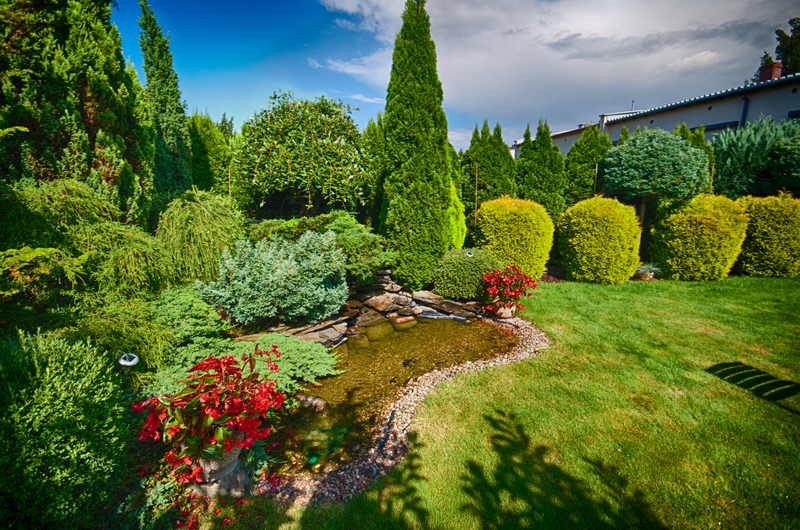This article is your guide to energy efficient landscaping. Energy efficient landscaping can be achieved with by either shade, windbreak, or ground cover landscaping which are ways to invest in your yard. This can lower your energy consumption and help with your comfortability in your home as temperatures rise in the world.
So, if you want to learn more about energy efficient landscaping, keep reading!
Here at The Energy Professor, we want to give you the information you need to not only save money on your energy bill but to also become more energy efficient. We hope find this post helpful! It makes it easier for you to know more about energy-efficient landscaping. Be sure to also check out our one-of-a-kind energy savings calculator!
The Energy Professor Electricity Rate Check Tool
What is Energy Efficient Landscaping?

Energy-efficient landscaping uses natural elements like trees and vegetation to reduce reliance on artificial climate control. By providing shade, creating windbreaks, and enhancing insulation, it effectively lowers energy consumption and your home’s carbon footprint. This approach not only tempers your home’s surrounding climate but also curbs wind velocity, making it an increasingly attractive option amidst rising energy costs. Energy-efficient landscaping stands out as a simple, yet impactful way to cut electricity expenses while fostering an environmentally friendly living space.
What are Different Types of Energy-Efficient Landscaping?
There are several types of energy-efficient landscaping techniques that homeowners can use to create an efficient landscape. These include:
- Shade Landscaping: This involves planting trees and shrubs to provide shade to your home, reducing the need for air conditioning in the summer months.
- Windbreak Landscaping: By planting trees and shrubs in specific areas, you can create a windbreak that reduces the impact of cold winds on your home, reducing your heating needs in the winter.
- Ground Cover Landscaping: Using ground cover plants can help to insulate the ground, reducing heat loss from your home.
Shade Landscaping
Shade landscaping is a technique that uses plants and trees to give natural shade to your home, reducing the amount of heat that actually reaches your home. With optimal placement of the trees, shade landscaping can reduce your home’s internal temperature by 20 degrees compared to unshaded areas. Plants suitable for shade landscaping are deciduous trees, which lose their leaves in the winter, allowing for solar heating, and vines that can be grown on trellises to shade windows, patios, and walls.
Windbreak Landscaping
Windbreak landscaping employs strategically planted trees and shrubs, especially evergreens, to shield your home from winter’s cold winds, effectively reducing heating costs. For optimal protection, these natural wind barriers are best situated on the north and west sides of your property, with a planting distance about two to five times the mature tree height from your home, blending functionality with the natural beauty of your outdoor space.
Ground Cover Landscaping
Ground cover landscaping utilizes fast-spreading, low-growing plants to form a dense vegetative layer, offering multiple benefits like minimizing soil erosion, hindering weed growth, and insulating the ground to reduce heat loss from your home. These plants are particularly effective in challenging yard areas where grass struggles or maintenance is sought to be minimized. They are also ideal for spaces under trees, where fallen leaves can inhibit the growth of other plants. With options like creeping thyme, carpet roses, and juniper, ground cover landscaping not only enhances functionality but also adds aesthetic appeal to your outdoor space.
Related Post: Why is Energy Conservation Important?
Techniques to Make an Energy-Efficient Landscape

Creating an energy-efficient landscape goes beyond mere tree planting. However, mastering efficient landscaping can be as straightforward as understanding the layout and orientation of your property. This knowledge forms the foundation for making strategic decisions about plant placement and landscape design, optimizing your yard’s energy-saving potential.
Here are some techniques you can use:
- Plant Trees Strategically: Plant deciduous trees on the south and west sides of your home. These trees will provide shade in the summer, and when they lose their leaves in the winter, they’ll allow sunlight to warm your home.
- Use Windbreaks: Plant evergreen trees on the north and west sides of your property to act as a windbreak, protecting your home from cold winter winds.
- Use Ground Cover Plants: Ground cover plants can help to insulate the ground and reduce heat loss. They also help to prevent soil erosion and water runoff.
- Install a Green Roof: If you’re really committed to saving energy, consider installing a green roof. This involves planting vegetation on your roof, providing additional insulation, and reducing heat loss.
Summer Energy-Efficient Landscaping
During summer, the objective of energy-efficient landscaping is to minimize air conditioning dependency by maximizing shade around your home and outdoor areas. Planting deciduous trees near windows and patios can effectively block intense sunlight. Additionally, incorporating structures like pergolas and outfitting them with climbing vines can create cool, shaded retreats, enhancing comfort and reducing the need for artificial cooling.
Winter Energy-Efficient Landscaping
In winter, the focus of energy-efficient landscaping shifts to minimizing heating requirements. Achieving this involves using landscaping elements to shield your home from piercing cold winds and harnessing the sun’s warmth. Strategically planting evergreen trees and shrubs on the north and west sides of your home can serve as an effective windbreak. Simultaneously, ensuring that south-facing windows remain unobstructed allows the winter sun’s rays to naturally warm your living spaces, reducing the reliance on artificial heating systems.
Related Post: What is Green Energy?
Energy Efficient Landscaping FAQ

Q: Does energy-efficient landscaping really make a difference?
A: Yes, it can. According to the U.S. Department of Energy, properly positioned trees can save up to 25% of a household’s energy consumption for heating and cooling.
Q: What types of plants should I use for energy-efficient landscaping?
A: Use native plants as they are adapted to your local climate and require less water and maintenance. Deciduous trees are great for providing summer shade and winter sun, while evergreens are excellent for windbreaks.
Q: Can I do energy-efficient landscaping on a small property?
A: Absolutely! Even on a small property, you can use energy-efficient techniques. Those include planting climbing vines on trellises to provide shade, or using ground cover plants to reduce heat loss.
Q: How much money can shade trees save you?
A: Well-placed trees can save up to 25% of a household’s energy consumption for heating and cooling, according to the U.S. Department of Energy. This could translate to annual savings of $100 to $250, depending on your local climate and energy costs.
Q: How is landscaping energy efficient?
A: Energy-efficient landscaping uses strategic planting of trees and other vegetation to provide shade, create windbreaks, and insulate the home. This reduces the need for artificial heating and cooling, thereby saving energy.
Q: How can I save money on my backyard landscaping?
A: You can save money on backyard landscaping by choosing native plants, which require less water and maintenance. Also, consider using mulch to reduce water evaporation, and install a drip irrigation system for more efficient watering. Reusing or repurposing materials can also cut costs.
Q: What are the energy-efficient plants?
A: Energy-efficient plants are typically those that are native to your area, as they require less water and care. Deciduous trees are energy efficient as they provide shade in the summer and allow sunlight in the winter. Evergreen trees are also energy efficient as they provide a windbreak in the winter. Ground cover plants can also be energy efficient as they help to insulate the ground and reduce heat loss.
Do you Need Cheaper Electricity?
If you’ve taken the time to understand the information on your bill and discovered you’re paying more than you’d like for your electricity, have you looked around for a cheaper deal? The Energy Professor has a wealth of information on ways to save on your utilities, including details of top deals that could significantly reduce your monthly or quarterly electricity bills.
We hope you found this article helpful! If you are looking for ways to increase energy efficiency and sustainability in your home be sure to take a look at all of the latest renewable energy options in your area. The Energy Professor helps residential and small business owners find qualified energy suppliers in New York, New Jersey, Pennsylvania, Texas, Ohio, Maryland, Illinois, and Massachusetts.


